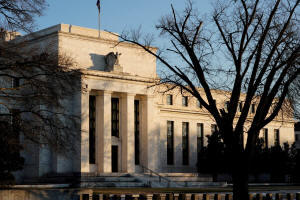Big Fed rate hikes ahead, amid early signs hot inflation is peaking
 Send a link to a friend
Send a link to a friend
 [April 30, 2022] By
Lindsay Dunsmuir and Ann Saphir [April 30, 2022] By
Lindsay Dunsmuir and Ann Saphir
(Reuters) - U.S. Federal Reserve
policymakers look set to deliver a series of aggressive interest rate
hikes at least until the summer to deal with hot inflation and surging
labor costs, even as two reports Friday showed tentative signs both may
be cresting.
Sharply higher food and gas prices lifted overall inflation to a new
40-year high of 6.6% in March, data from the Commerce Department showed.
At more than triple the Fed's target, hot inflation is why the central
bank is widely expected to ramp up the pace of rate hikes with a
half-point increase at each of its next three meetings, and continue
raising rates through the end of the year.
Contracts tied to the Fed's policy rate now show heavy bets on interest
rates rising to a range of 3%-3.25% by the end of the year, putting
borrowing costs well into territory U.S. central bankers believe will
put the brakes on growth.

But the inflation measure tracked most closely by the central bank as a
signal of underlying price pressures, known as the core personal
consumption expenditures price index, slowed slightly to 5.2% in March,
from 5.3% the prior month. The report, from the Commerce Department,
also contained fresh evidence of a shift toward spending on services
that Fed policymakers hope will also ease upward price pressure, as
spending on durable goods declined.
Meanwhile a separate report showed employers jacked up benefits to
attract historically-scarce workers, accelerating the pace of employment
cost increases to 4.5% and underscoring the Fed's view that the labor
market is extremely and perhaps unhealthily tight. But private wage
growth leveled off, at 5%.
The reports "won't stop the Fed from hiking by 50bp next week, but it
supports our view that inflation will fall a little more quickly this
year than Fed officials now appear to expect," said Andrew Hunter,
senior U.S. economist at Capital Economics.
The Fed, and particularly its chief, Jerome Powell, is taking nothing
for granted after being burned several times over the past two years in
its assessment of inflation pressures that refused to wane as predicted.
[to top of second column] |

The Federal Reserve building is seen before the Federal Reserve
board is expected to signal plans to raise interest rates in March
as it focuses on fighting inflation in Washington, U.S., January 26,
2022. REUTERS/Joshua Roberts/File Photo

"We want to see actual progress on inflation," Powell said just over a week ago,
citing another round of possible sustained upward inflation pressures caused by
the war in Ukraine and recent COVID-19 lockdowns in China prolonging supply
chain issues. "It may be that the actual peak was in March but we don't know
that and so we're not going to count on it."
At its policymaking meeting next week, the Fed is set to raise interest rates by
a bigger-than-usual half percentage point as it seeks to tamp down overall
demand that has far exceeded supply in both labor and goods. It is also set to
give the nod to starting the process of reducing its asset holdings as another
way to tighten financial conditions.
Some analysts took no comfort from either of Friday's reports, noting that the
continued rise in overall labor costs keeps fears of a wage-price spiral in
play.
"These readings – which are showing no sign of easing - will be of concern to
policymakers as they make decisions about monetary policy in an environment
where the labor market is tight, and prices are at a 40-year high," wrote HFE's
Rubeela Farooqi.
American household sentiment perked up in April, the widely followed University
of Michigan surveys of consumers showed Friday, as gas prices softened. But it
remained near a ten-year low, and the specter of steep Fed rate hikes and what
economists say is the rising chance of a resulting recession could weigh in
months ahead.
"Monetary policy now aims at tempering the strong labor market and trimming wage
gains, the only factors that now support optimism," wrote the surveys' chief
economist, Richard Curtin.
(Reporting by Lindsay Dunsmuir and Ann Saphir; Editing by Chizu Nomiyama)
[© 2022 Thomson Reuters. All rights
reserved.]This material may not be published,
broadcast, rewritten or redistributed.
Thompson Reuters is solely responsible for this content.
 |